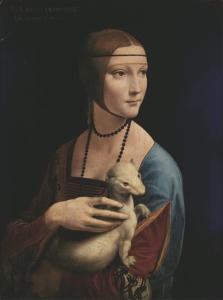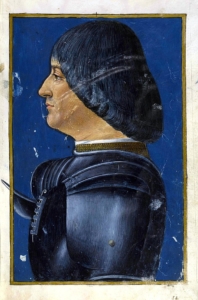Lady with an Ermine is a painting by Leonardo da Vinci that is one of the most important and well-preserved works of the Renaissance Man. It comes from the same period as the Mona Lisa and the Vitruvian Man. Before you get a chance to see it for yourself in the Czartoryski Museum in Krakow, Poland.
“Lady with an Ermine” – basic info

“Lady with an Ermine” is a three-quarter profile portrait of Cecilia Gallerani holding an oversized white ermine. The work was painted with oil on a walnut board. She is standing with her body pointing to the left side of the board, but both her and the ermine are looking at the same point outside the right side of the painting. The background is pitch black, with the only notable feature being a gold-coloured inscription that says “LA BELE FERONIERE. LEONARD D’AWINCZI”.
It’s generally believed the model was Cecilia Gallerani, a mistress of Ludovico Sforza, Duke of Milan. It was painted by Leonardo sometime around 1491, during his time working directly for the Duke.
Cecilia Gallerani – the Lady in question
The subject of the painting is identified with reasonable certainty as Cecilia Gallerani – court lady and known lover of Ludovico Sforza. She was born in 1473 is Siena to a middle class family. Her father is known to have been a diplomat and ambassador at multiple Italian republics of the time. Her mother was a daughter of a noted doctor of law.
Cecilia’s upbringing
Cecilia, in spirit of the times, received a complete education in Latin and literature, along with her six brothers. It’s known she was betrothed to a member of the Visconti family, but the arrangement was broken off shortly after. At around 16 years old, she left home to continue her studies at Monastero Nuovo, where she presumably met Ludovico for the first time.
Her connection to the Milanese court
Shortly after Ludovico’s visit to the monastery, Cecilia was offered a job as a lady-in-waiting at Castello Sforza. She quickly made a name for herself among the intellectual elite for her talents as a musician, poet and conversationalist. Around the same time, the Duke started an affair with her, which resulted in an illegitimate son named Cesare.
Unfortunately, they could never marry due to her lowborn status. Soon after Il Moro‘s wedding with Beatrice d’Este, Cecilia and her son were moved away. However, the Duke still provided for her by giving her a palace and marrying her off to Count Lodovico Carminati di Brambilla.
The Symbolism of “Lady with an Ermine”
Here’s some historical context – Leonardo da Vinci was working at Sforza’s court for at least 7 years prior to the creation of the portrait, and so he was deeply aware of its inner workings.
That being said, there could be many different symbolic reasons why he chose to portray her with an ermine:

Reason 1 – A reference to Il Moro’s legacy
The work was commissioned by Ludovico Sforza himself, so it’s possible that Da Vinci wanted to reference him in some way. Therefore, the ermine could be connected to the Order of the Ermine – an equestrian order the Duke was a part of.
Reason 2 – An ancient symbol of pregnancy
As suggested by art historian Krystyna Moczulaska, in some classical literature, ermines and weasels are portrayed as protectors of pregnant women. It’s been deducted that at the time of the painting’s creation, Cecilia gave birth or was pregnant with hers and the Duke’s child, Cesare Sforza
Reason 3 – A symbol of purity and moderation
Other sources note that ermines used to serve as a symbol of purity and moderation. The belief was based on an observation that they would go out of their way to avoid soiling their winter coat. Later in life, Leonardo da Vinci created a bestiary, where he reinforces that belief.
Reason 4 – A play on Cecilia’s family name
The Ancient Greek name for ermine is “galê”, which could make it an allusion to Cecilia’s family name, Gallerani. If you think that the greatest artist of the Italian Renaissance is above puns, think again. After all, there’s an even more obvious example in another portrait of his, Ginevra de Benci, where Ginevra’s visage is framed with a juniper tree – or ginepro in Italian.
Turbulent history of Lady with an Ermine by Leonardo DaVinci
While it was always known that there is a portrait of the mistress of Leonardo’s employer, we only learned the real history of the painting in the 20th century. Cecilia Galleriani most likely kept the portrait after leaving Castello Sforza. According to correspondence found between her and Isabella d’Este, the painting was brought back to Milan at least once, as the Duchess was an avid enjoyer of da Vinci’s works.
Acquisition of the painting by the Polish Czartoryski family
The next definitive moment in history of “Lady with an Ermine” was when the painting was acquired in Italy by Prince Adam Jerzy Czartoryski in 1798, almost 300 years after the last documented piece of history of this painting. He presented it to his mother, Izabela Czartosryska Flemming, who was in the process of gathering works for the Czartoryski Museum – the very first Polish museum.
Interestingly, while Prince Adam was certain the portrait was a Leonardo painting, he misidentified the sitter to be the same woman as in Leonardo’s other oil portrait, La Belle Ferronnière. This is where the inscription on the top side of the painting comes from – it was added soon after its arrival in Puławy. Additional repaints were commissioned at the time, including some touch-ups on the face, as well as a full background recolour.
Painting preservation efforts after the Partitions of Poland
The painting was forced to travel on several occasions due to wars and uprisings:
- In 1830, it was twice moved for safekeeping during the November uprising – first to another Czartoryski palace in Sieniawa, then to Paris. It only returned to Krakow in 1876.
- In 1914, it was moved to Dresden in the wake of World War I. It was sent back in 1920.
- In 1939, it was discovered by the Nazis in the Sieniawa Palace and sent to the Kaiser Friedrich Museum in Berlin.
- In 1940, Hans Frank requested the return of the painting to Krakow, so that he can display it in his personal offices in Wawel Castle.
- During Nazi Germany’s retreat, Frank has taken the painting back to his country home in Bavaria, where it was discovered by Allied Forces in 1945.
Polish Government’s buyout of the Czartoryski collection
After World War II, “Lady with an Ermine” mostly remained at the Czartoryski Museum in Krakow, located at the north border of the Old Town, nearby Main Train Station. The only exceptions were a few international exhibitions, as well as a 2-year transfer to the Krakow National Museum during Czartoryski Museum’s renovation.
Adam Karol Czartoryski, last direct descendant of Izabela and Adam Jerzy Czartoryskis, established the Princes Czartoryski Foundation in 1991 as a body governing over Czartoryski Museum under the jurisdiction of Krakow National Museum.
However, to complete surprise of the Foundation officials and his daughter Tamara, he has sold the entire collection to the Polish government for a bargain price of €100 million (for context, the collection was worth €2 billion at the time). The deal was signed on December 29th 2016 by the Prince and Piotr Gilinski, the Polish Minister of Culture at the time.
View “Lady with an Ermine” at Czartoryski Museum in Krakow
Renovation of the Czartoryski Palace finished in 2019, and since then, it has remained in Krakow except for a few exhibitions in the late 20th century. If you want to see the incredible Czartoryski collection, featuring works from Da Vinci, Rembrandt and Raphael, come and visit Krakow. Take in the wonderful aura of the City of Kings with one of our Krakow Tours.

FAQs
Who is on the “Lady with an Ermine” portrait?
Cecilia Gallerani is largely considered to be the model on the painting. She was a lady-in-waiting while Leonardo was in the service of the Duke of Milan. She and the duke had an affair which resulted in a child before she was forced to leave the palace by Sforza’s new wife, Beatrice d’Este.
Why is the lady holding an ermine?
The ermine is way too large to be realistic, therefore experts are in agreement that it’s meant to be symbolic. It could refer to Cecilia Gallerani’s pregnancy with Ludovico Sforza’s son, the Duke’s allegiance to the Order of the Ermine, serve as a symbol of purity and dignity, or be a subtle reference to her name.
In which museum is the Lady with an Ermine currently housed?
“Lady with an Ermine” is currently on permanent display in Czartoryski Museum, a wing of Krakow National Museum. The address is: Pijarska 15, 31-015 Kraków, Poland.
Are there virtual exhibitions available for those unable to visit?
As of writing this article, the museum website is down, but we will update the article when the virtual tour will go back online.















